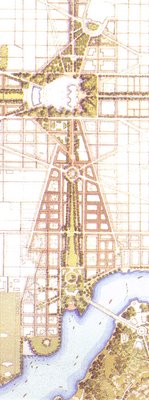Promenade or just a Boulevard?
Which Legacy to extend?
 The McMillan Plan extended the parklands of the National Mall further west.
The McMillan Plan extended the parklands of the National Mall further west.The 1997 National Capital Planning Commission's "Extending the Legacy: Planning America's Capital for the 21st Century" features a new promenade along the South Capitol axis.
The original L'Enfant Plan features only one promenade, that of the National Mall between the
If speaking strictly about the L'Enfant plan, "extending the legacy" may or may not include the idea of a narrow

If speaking about the plans of L'Enfant, and of the later McMillan Commission, "extending the legacy" would very likely include the idea of a broad South Capitol Street corridor right of way. If speaking about these plans together with later (1920s-40s) plans for an "East Capitol Street Mall" with a new promenade and buildings replacing the still extant Victorian dwellings, a "South Capital Street Mall" is infinitely more likely, since with but one exception, the buildings lining it are architecturally expandable. That would be the apparant conclusion of the majority of the architects, urban designers, economists and transportation planners involved with the U.S. National Capital Plaanning Commission's 1992-96 planning endeavor "Extending the Legacy".
If there was any discussion or debate anywhere within architectural and planning circles (or elsewhere- including political), this blogger would be interested in seeing some leads.
Who out there would explicitly denounce the "City Beautiful" movement?




No comments:
Post a Comment